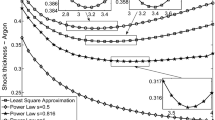Abstract
A hydroshock in a two-phase gas-liquid mixture is usually calculated by an analog of the Zhukovskii formula for a mixture (see, for example, [1, 2]) which establishes the relation of the hydro-shock intensity to the velocity of sound in the mixture. However, as the experimental data [1] show, the hydroshock intensity in the mixture can significantly exceed the calculated values, a fact which is explained by the increase in the propagation velocity of the perturbation wave in comparison to the velocity of sound in the mixture [3, 4]. In the present paper, an equilibrium model of shock transition, similar to [5, 6], is used to calculate the attenuation of the hydroshock as the gas content of the mixture increases in a bubble flow regime. It is shown that owing to the high compressibility of the mixture the effect of the elasticity of the pipe-line walls is small, and the dependence of the propagation velocity of the perturbation wave on the intensity and gas content becomes the main effect. A simple dependence of the hydroshock intensity on the gas content and two similarity parameters is obtained.
Similar content being viewed by others
Literature cited
K. Akagawa, T. Sakaguchi, and T. Fujii, “An investigation of shock waves in two-phase flows. Part 1. Flows with air-bubbles,” Trans. Jpn, Soc. Mech. Eng.,B46, 492 (1980).
N. G. Zubkova, “Features of hydraulic shock in two-phase gas-liquid flows,” Gidrotekh. Stroit., No. 7, 29 (1978).
A. A. Borisov, B. E. Gel'fand, E. I. Timofeev, and S. A. Tsyganov, “Unsteady motion in a column of a two-phase mixture under the influence of suddenly applied pressure,” Dokl. Akad. Nauk SSSR,262, 595 (1982).
B. E. Gel'fand and E. I. Timofeev, “An investigation of hydroshock in hydrodynamic shock tubes,” Teplofiz. Vys. Temp.,21, 330 (1983).
B. E. Gel'fand, S. A. Gubin, and E. I. Timofeev, “The reflection of plane shock waves from a wall in a gas-bubble-liquid system,” Izv. Akad. Nauk SSSR, Mekh. Zhidk. Gaza, No. 2, 174 (1978).
B. R. Parkin, F. R. Gilmore, and G. L. Broud, “Shock waves in water with air-bubbles,” in: Underwater and Underground Explosions [Russian translation], Mir, Moscow (1974), pp. 152–258.
Author information
Authors and Affiliations
Additional information
Translated from Izvestiya Akademii Nauk SSSR, Mekhanika Zhidkosti i Gaza, No. 5, pp. 202–204, September–October, 1984.
Rights and permissions
About this article
Cite this article
Kovalev, A.D., Shindyapin, G.P. A theory of hydroshock in a two-phase gas-liquid mixture. Fluid Dyn 19, 851–853 (1984). https://doi.org/10.1007/BF01093563
Received:
Issue Date:
DOI: https://doi.org/10.1007/BF01093563




